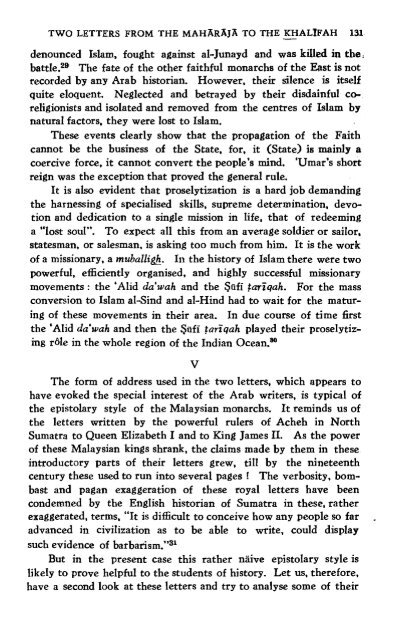TWO LETTERS FROM THE MAHARAJA TO THE KHALIFAH
TWO LETTERS FROM THE MAHARAJA TO THE KHALIFAH
TWO LETTERS FROM THE MAHARAJA TO THE KHALIFAH
Create successful ePaper yourself
Turn your PDF publications into a flip-book with our unique Google optimized e-Paper software.
<strong>TWO</strong> <strong>LETTERS</strong> <strong>FROM</strong> <strong>THE</strong> <strong>MAHARAJA</strong> <strong>TO</strong> <strong>THE</strong> KHALfFAH 131<br />
denounced Islam, fought against al-Junayd and was killed in the.<br />
battle.29 The fate of the other faithful monarchs of the East is not<br />
recorded by any Arab historian. However, their silence is itself<br />
quite eloquent. Neglected and betrayed by their disdainful coreligionists<br />
and isolated and removed from the centres of Islam by<br />
natural factors, they were lost to Islam.<br />
These events clearly show that the propagation of the Faith<br />
cannot be the business of the State. for. it (State) is mainly a<br />
coercive force. it cannot convert the people's mind. 'Umar's short<br />
reign was the exception that proved the general rule.<br />
It is also evident that pr~sel~tization is a hard job demanding<br />
the harnessing of specialised skills, supreme determination, devotion<br />
and dedication to a single mission in life, that of redeeming<br />
a "lost soul". To expect all this from an average soldier or saiIor,<br />
statesman, or salesman, is asking too much from him. It is the work<br />
of a missionary, a muballi&. In the history of Islam there were two<br />
powerful, efficiently organised, and highly successful missionary<br />
movements : the 'Alid da'wah and the Siifi tarZqah. For the mass<br />
conversion to Islam al-Sind and al-Hind had to wait for the maturing<br />
of these movements in their area. In due course of time first<br />
the 'Alid daswah and then the Safi tariqah played their proselytizing<br />
r61e in the whole region of the Indian O ~ean.~<br />
The form of address used in the two letters, which appears to<br />
have evoked the special interest of the Arab writers. is typical of<br />
the epistolary style of the Malaysian monarchs. It reminds us of<br />
the letters written by the powerful rulers of Acheh in North<br />
Sumatra to Queen Elizabeth I and to King James 11. As the power<br />
of these Malaysian kings shrank, the claims made by them in these<br />
introductory parts of their letters grew, till by the nineteenth<br />
century these used to run into several pages ! The verbosity. bom-<br />
bast and pagan exaggeration of these royal letters have been<br />
condemned by the English historian of Sumatra in these, rather<br />
exaggerated, terms, "It is difficult to conceive how any people so far -<br />
advanced in civilization as to be able to mite. could display<br />
such evidence of barbari~m."~~<br />
But in the present case this rather naive epistolary style is<br />
likely to prove helpful to the students of history. Let us, therefore,<br />
have a second look at these letters and try to analyse some of their
















